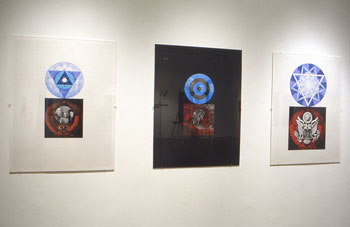
Study for Three-Day Weekend Stained Glass, 2004-2005.
Mixed media on paper,
40" x 30".
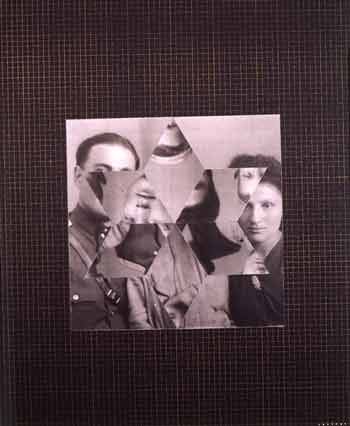
Fragile Unity #1, 2004-2005.
Mixed media on paper,
40" x 30".
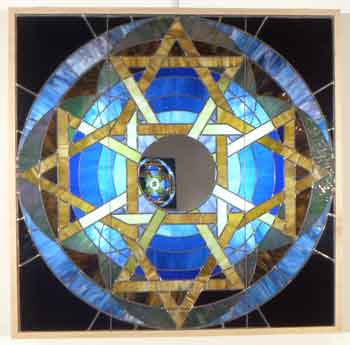
Four Moons as Part of a Snowflake, 2004-2005.
Mixed media on paper,
40" x 30".
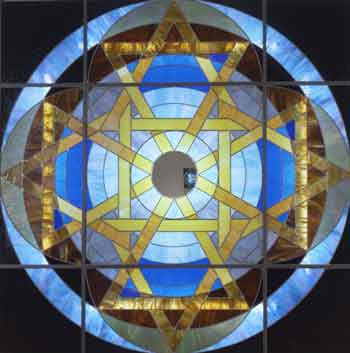
Self-portrait in a Mandala, 2004-2005.
Mixed media on paper,
40" x 30".
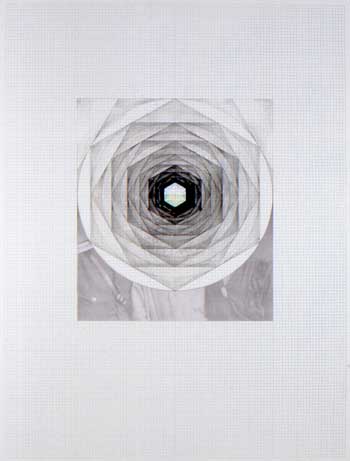
Three-Day Weekend Big Stained Glass with Mirror, 2004-2005.
All the drawings and collages are mapped on graph paper, as though everything might be accounted for by coordinates. There are rectangles, squares, triangles, circles, hexagons, trapezoids, Jewish stars, crosses, yin-yang symbols, the Ouroboros (the cosmic serpent that swallows its tail), Russian and Soviet heraldry, hammer and sickle, American heraldry, hour glass, snowflake, and combinations of these. They represent, in a sense, various belief systems (some religious, some scientific), ways in which the aggregate human mind quantifies, qualifies, and controls experience. As collective, philosophical constructions radiating from human thought, they represent something larger and more portentous than individual consciousness, shaped as they are in geometric and symbolic form. When human images appear, as they invariably do in these pictures, it is something like thinking about Einstein, his theories, and the actual physical operation of the universe at the same time.
Six people are in these works, together and apart: Winston Churchill, Franklin D. Roosevelt, and Josef Stalin (at the Yalta Conference in 1945); six-year-old Vitaly Komar between his Jewish mother and his Soviet army father (in a photo of the late 1940s). There is a basic contradiction, of course, in both triads, and an almost infinite number of contradictions beyond the basic one. The three statesmen represent a united front of nations that won the world war and would establish world peace. The mother, father, and son are a cell of the larger triad, or perhaps it's the other way around. In any case, both groups splintered (both shortly after the photos were taken), the world leaders in a cold war of perceived and manipulated national imperatives, Komar's family through divorce, apparently based mostly on cultural differences. The artist never saw his father again, though he did once, as a boy, briefly see Stalin.
Connections between the two triads are directly plotted in a series of four variations called Fragile Unity. The first and most basic, which was not in the show, is a circle within a square in the middle of a dark graph paper field. In the upper half of the circle are Komar's family, in the lower half the three leaders at Yalta. But the circle has been superimposed onto the square, which had the Yalta group in the upper half and the Kolmar group in the lower half, remnants of which can be seen in corners behind the circle (parts of the father's head on the bottom, the legs of Stalin and Churchill on the top) and are missing from the photographs in the circle. The constructs of circle and square engender an impossible reconciliation. And then there are more complicated arrangements in this series: triangles, circles, and squares juxtaposing heads and bodies from both groups in oppositional conglomerations that allow for containment but no resolution.
The circle is the principal configuration, as it is generally in our perception of the world, literally of the earth, the moon, all heavenly bodies, the solar system, the universe, the eye, the head (more poetically), the flower, the nucleus. The circle is continuous, contains all things, and yet is indefinite because there is felt always to be something outside it. Four Moons as Part of a Snowflake casts the two triads of figures to the outer edges of the moon, left and right, between four points of a Jewish star, and at the end of two of six crosses. The process can be understood to begin at the center, from which there is repetition and expansion of the structure outward to, one supposes, infinity. Along the way are the two groups of people within the first circle, and god knows what else. But as the lines extend outward on the graph paper, the circle always contains and is exceeded by the star and the crosses as many times as they assert themselves. The snowflake encompasses the moon.
We exist at the center of a circle ranging 360 degrees around us. The circle includes, of course, other circles, other people's circles, other systems' circles. Parts of the circles of Muslim, Jewish, and Christian holy days--Friday, Saturday, and Sunday--are joined by a triangle in Komar's Mandala of the Three-Day Weekend. During the course of the show, the artist took Polaroids of individual people as they appeared through the hole at the center of the mandala, and the photos were then arranged in a grid on the gallery wall behind. The self is recognized as the center of all things and the place where reconciliation can occur, once and many millions of times beyond count. When Komar himself appears in Self-portrait in a Mandala, he is on the roof of the building in which he lives in New York, in the midst of a very particular set of diagonals and grids formed by railings, walls, water-tower pedestals, and other buildings, much like the graph paper and the geometric configurations of his other work. It is where everything is at that moment, from this angle, and the circles, including the artist, are within the circle.
In Three-Day Weekend--Big Stained Glass with Mirror, the circle at the center is a mirror, so that one sees one's own face and the smaller stained-glass piece on the opposite wall in reverse, as though time were collapsing backward. The four Jewish stars, the circles around the central mirror, the square around the center, and the square outer frame of the piece seem now to refer back to the reflection at the center. The space beyond has been relocated at the center, which becomes the sum total rather than peripheral product of this intricate, interlocking web.
Donald Goddard © 2005